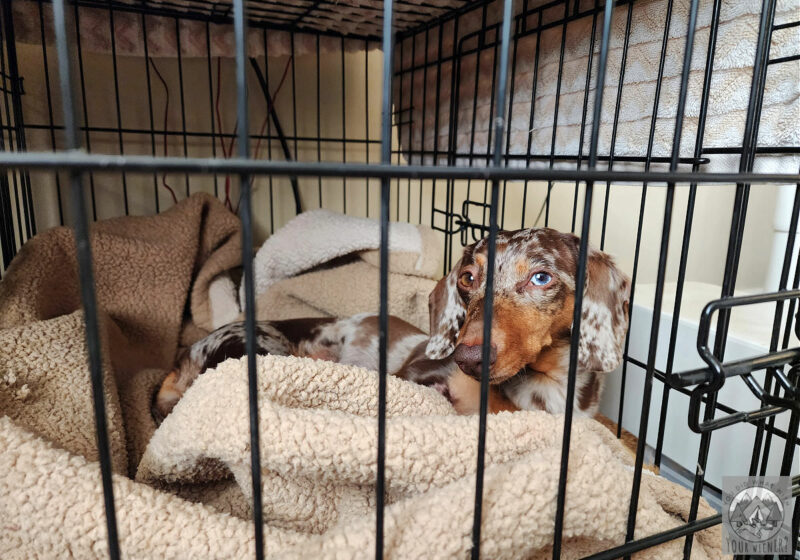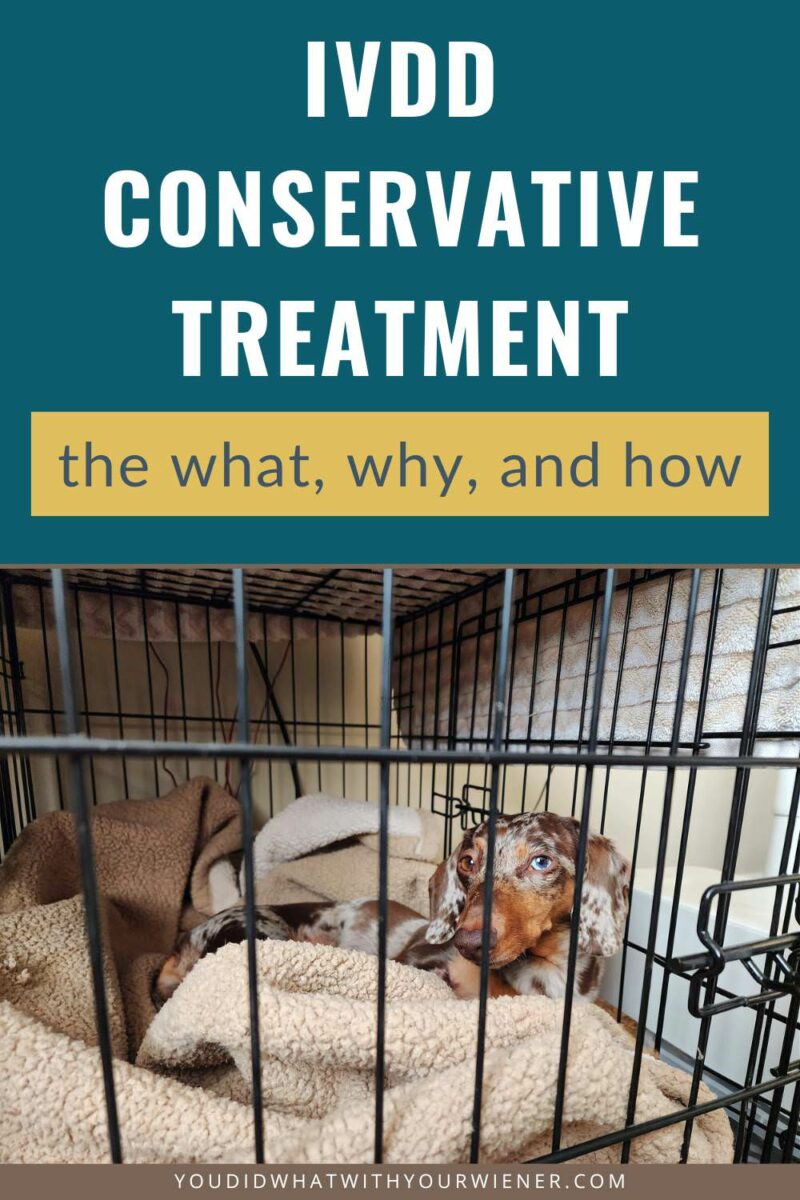What is Conservative Treatment for IVDD in Dogs?
If your Dachshund has suffered a back injury and been diagnosed with Intervertebral Disk Disease (IVDD), conservative treatment, sometimes referred to as “crate rest”, may be recommended.
In this article, I explain what IVDD is, when conservative treatment will be recommended, and what to expect, including the cost and chance of recovery.
A Quick Summary of Intervertebral Disk Disease (IVDD)
Intervertebral disk disease (IVDD) is a condition in dogs where the cushion-like discs between the vertebrae of the spine degenerate and bulge or rupture, causing pressure on the spinal cord or nerves.
Symptoms of IVDD in dogs may include back pain, reluctance to move or walk, weakness or paralysis in the limbs, and incontinence.
IVDD is most common in certain breeds, including Dachshunds, Frenchies, Beagles, Chihuahuas, and Corgis.
However, IVDD affects the Dachshund breed the most, being present in approximately 98% of them to some degree.
Thankfully, although most Dachshunds have the genetic disease, since it’s related to the chondrodystrophy, or dwarfism, gene (which gives the Dachshund a long body but short legs) only about 25% will be noticeably affected in their lifetime.
If you want to learn more, you can read in-depth about IVDD and dog back problems in my article The Truth About Dachshunds and Back Problems.
When IVDD causes a spinal disk to rupture and put pressure on your dog’s back nerves, conservative treatment may be recommended as the best course for healing and recovery.
Note: The other, most common treatment recommendation is back surgery.

When is Conservative Treatment Recommended for a Dachshund?
Whether or not your veterinarian recommends conservative treatment, aka. strict crate rest, as the primary treatment for a disk rupture depends on their experience with IVDD, the degree of back injury, and the chance of recovery with this method of treatment.
If you take your dog to the vet with a suspected back problem, they will evaluate your dog’s pain level, the degree of feeling in their limbs, and grade the severity of injury on a scale from 1 to 5, with 1 being the mildest case and grade 5 being the most severe.
At grades 1 and 2, which are considered mild, conservative (non-surgical) treatment is often the initial recommendation, at least until, and if, it becomes clear that your Dachshund is not healing on their own.
Do know that even if your dog does get back surgery, a period of conservative treatment will be required after to ensure the spine heals properly.
Also, although not common, some owners opt to go the conservative treatment route despite a surgery recommendation due to the cost (surgery costs and average of $10,000) and personal feelings about it.
What is Conservative Treatment for IVDD in Dogs?
Conservative treatment for intervertebral disk disease (IVDD) in dogs is a way of managing the condition without surgery.
Conservative treatment for IVDD in dogs may include:
Crate rest
Strict crate rest means keeping your dog in a crate or small pen to limit movement, prevent further damage to the spinal cord or nerves, and allow scar tissue to form over the affected spinal disks.
This is the key component of conservative treatment and healing is not possible unless this is implemented.
Medication
Initially, a steroid may be administered to your dog to jumpstart the healing process.
Anti-inflammatory medications and painkillers will be prescribed to relieve pain and inflammation associated with IVDD during the recovery period.
Physical therapy
Physical therapy exercises for IVDD, such as range-of-motion, massage, core strengthening exercises, and hydrotherapy may be recommended to improve mobility and reduce pain.
Alternative therapies
Alternative therapy techniques such as acupuncture or cold laser treatments may also be used to manage pain, stimulate the body’s natural healing process, and improve mobility in dogs with IVDD.
Conservative treatment for IVDD typically requires close monitoring by a veterinarian and may need to be adjusted based on the dog’s response to treatment.
In some cases, if a dog does not improve through conservative treatment alone, surgery may become necessary to treat their back injury after all.
This is especially true if the dog continues to experience severe pain and the symptoms, like weakness in the limbs, progress.
Will My Dog Fully Recover with Conservative Treatment?
Whether your dog fully recovers from an IVDD-related back injury through conservative treatment alone (ie. only using non-surgical methods) depends on your particular dog and how strictly you adhere to the protocol.
Genetics plays a very significant factor in your dog’s recovery.
Some dogs have severe disk generation that causes the disk condition to get worse or for other disks in the spine to rupture after the first assessment was done.
In my experience, almost all Dachshunds who were diagnosed with grade 1 or 2 disk injuries fully or mostly recover with 6-12 weeks of conservative treatment.
Officially, it has been reported that the recovery prognosis for dogs at grade 1 or 2, opting for non-surgical (conservative) treatment, is 95% to 100% (source).
It’s also been my experience that the majority of Dachshunds who receive surgery immediately, and then complete 4-6 weeks of conservative treatment, fully or mostly recover.
However, the actual reported success rate for conservative treatment with surgery at grades 4 or 5 (when surgery is most often recommended) is 50% to 90%.
If a dog is grade 4 or 5 and surgery is recommended, but an owner opts for the non-surgical conservative treatment option anyway, the recovery prognosis is only 30% to 80%.
So, if your question is whether a dog can recover from an IVDD-related injury without surgery, the answer is absolutely if caught early and the injury is only at grade 1 or 2.
At grates 3-5, the outcome is less certain, and it is reasonable to anticipate your dog may never walk again or will at least have mild mobility issues if you don’t do surgery before the conservative treatment.
What Does Conservative Treatment Cost?
When I see discussions around cost and IVDD injury treatment, it always revolves around the surgery cost, which is shockingly high (around $10,000).
However, I think it’s important that people be made aware conservative treatment is not free, and not necessarily cheap.
In a nutshell, depending on all of the methods employed, and the duration of the conservative treatment period, the cost can easily reach $5,000, which is half the cost of back surgery.
At the cheapest end, if one only does the crate rest and absolutely nothing else, I would expect the conservative treatment cost to be at least $500.
Even assuming someone already has a dog crate that will work for conservative treatment, there will be costs associated with:
- Potty pads to place under the dog in the bed in case they have an accident
- Missed work to properly care for your dog (yes, that counts as an expense too)
- Possibly equipment like a sling to support your dog when they are outside using the bathroom.
If someone – like I did – does everything possible within the conservative treatment protocol for 10 weeks, the cost will be closer to the $5,000 mark.
My costs included:
- Visits to a rehab veterinarian to check on progress and for treatment recommendations
- Hydrotherapy (walking on an underwater treadmill)
- Sessions at a dog gym for strengthening exercises
- Acupuncture
- A dog stroller to use as a mobile crate and so I could take my Dachshund for walks outside
- Pet CBD to help her stay still and calm during crate rest.
Ironically, my pet insurance would have covered 90% of back surgery after my deductible but did not cover any of the conservative treatment (I think they would have covered the cold laser, but I was too distressed to make the claim).
Therefore, I actually paid more for conservative treatment than I would have for surgery.
However, since conservative treatment is recommended after surgery, although typically for a shorter period of time, I probably would have ended up paying close to the same amount out of pocket.
Final Thoughts
When a dog suffers a back injury, conservative treatment is always recommended.
Sometimes it’s recommended as a non-surgical treatment option and other times it is recommended as a follow-up to surgery for proper healing.
Conservative treatment is sometimes simply referred to as crate rest because confining your dog to a small space, like a dog crate, to keep them as still as possible is the primary component of conservative treatment.
But crate rest is not the whole picture.
Conservative treatment can also include massage, exercises to strengthen muscles, acupuncture, cold laser treatment, and more.
If the injury due to disk degradation is low-grade (score 1 or 2), and acted on early, the chance of recovery with crate rest alone is close to 100%.
If surgery is recommended for higher grade injuries, it’s still possible for a dog to recover without surgery but the recovery prognosis in that case is closer to 30% to 80%.
Unfortunately, regardless of the degree of recovery, since IVDD is a genetic disease that deteriorates the spinal disks, there is a chance that a different disk can rupture and cause an injury in the future.
I hope this information about conservative treatment helps you understand what it is, how to properly implement it, and gives you hope for a positive outcome.


About the Author
Hi, I’m Jessica. I’ve been studying the Dachshund breed since 2007, owned 3 of my own, and shared in the lives of thousands of others through their owner’s stories. When I’m not sharing what I know on this blog, you can find me hiking, camping, and traveling with my adventurous wiener dogs.
